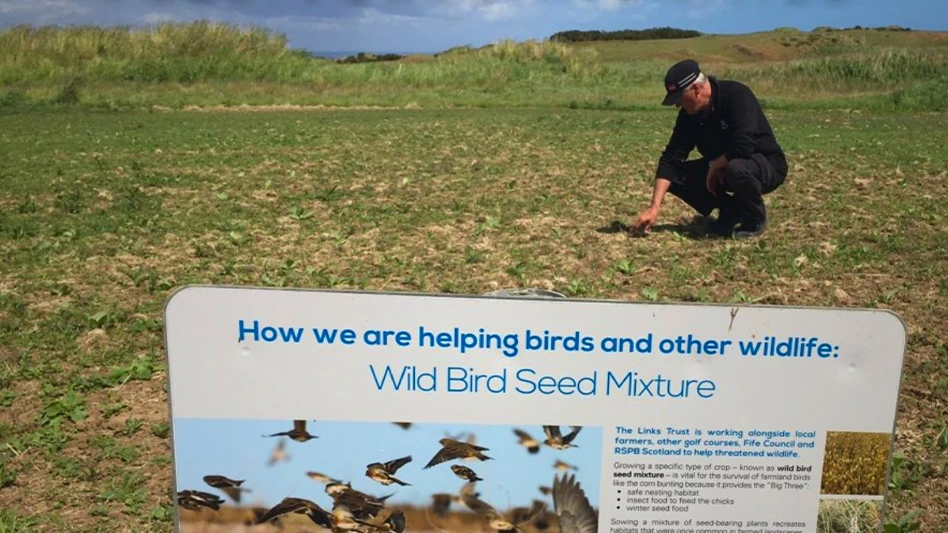 At Utrect de Pan in the Netherlands, the soil is heavily hydrophobic. To test their wetting agents, they treated one half of their fairway with Revolution, maintained as usual and then photographed the results. At Utrect de Pan in the Netherlands, the soil is heavily hydrophobic. To test their wetting agents, they treated one half of their fairway with Revolution, maintained as usual and then photographed the results. |
Farmington Country Club. One of the biggest parts of disturbing the turf to improve its health is also disturbing it as little as possible for play, especially when it comes to deep-tine aerification.
Brad Graves, golf course equipment manager at Farmington Country Club in Charlottesville, Va., knows the pressure from members all too well. But he doesn't lose sleep over his 27 healing A4 greens. He uses a Wiedenmann GXi 8 HD throughout the course and says he sees playable greens faster than his members can really complain.
"You always want to make sure you impact the golf as little as you have to," says Graves. "I don't think we've heard any complaints. We'll run the 5/16 tines and then roll behind it. You can see the holes right then, but after three or four days, they've filled in already."
Graves runs the 5/16 tines a few times during the season and really opened up the turf in the first part of the year with half-inch tines. He'll run another round of the half-inch tines in September to finish out the season. The machine's turfguards kept Farmington Country Club's greens from getting torn up any more than necessary.
"One of our biggest concerns initially was with the turfguards," Graves says. "But we've had no issues whatsoever. Coming into a contoured green now, we don't have to be as nervous. The biggest problem we've really ended up dealing with were just the tire tracks."
The only other issue Graves has comes from a lack of operator visibility to the tines themselves.
"If you have greens that have a lot of rock on them, that would be something that you'd have to notice," he says. "If you're running a deeper tine on this machine, you have to pay attention to it and raise it a little higher to make sure it clears."
Besides the visibility, training has come fairly easily for the crew, he says. Graves runs the machine at about a five degree offset to help the tines clear the edges better, which he sets through one of the crank screws.
"That's probably the biggest training issue we've got – making sure that when they stop and start they're at the right height," he says. "With the tractor we have you have to raise the machine just that little bit higher than what I might say a mechanic might be comfortable with to start. Otherwise, you just have to be at the right height to make sure you're not dragging the tines across the front part of the collar. It's almost like a soothing, smooth ride."
As the equipment manager, what really stands out to Graves is how easily the machine is repaired and adjusted.
 Though it holds up play, deep tine aeration is important to help water move freely through the soil profile. Though it holds up play, deep tine aeration is important to help water move freely through the soil profile. |
"Tine replacements are easy," he says. "You're going to hit a rock and you're going to bend a tine. That's something we have to look for as mechanics and operators. You open that big hatch up and there's all this nice room in there you can move your hands around in nice and easily. Everything on the Wiedenmann is on the outside of the machine, which is extremely nice."
But for he and his crew, it keeps coming back to how quickly the turf heals from aerification, getting back to regular, stronger growth.
"Even with the half-inch tines, there was minimal disturbing of the turf," he says. "With the 5/16, you could still see the holes, but they were already covered in three days."
Nashawtuc Country Club. It's dry at Nashawtuc Country Club, in Concord, Mass. The weather's been oppressive to the turf of the 18-hole, 50-year-old private course throughout the summer.
But Greg Cormier, superintendent, can stand the heat. He likes to keep his bent Poa tees, greens and fairways a little drier, keeping his distance from summer stress on the turf while avoiding damp greens and surface puddles from overeager watering on saturated soil. A wetting agent program is a part of what lets him ride comfortably between those extremes.
"It basically allowed me to keep my greens a little firmer," says Cormier. "You can really see the effects on the green. It just sucks the water down into the profile. You can't make a puddle on the greens at all. It really makes the best of our hand watering of the greens, which we do pretty exclusively."
Cormier uses Cascade as the biggest part of his program, though he does also work in Duplex, Magnus and Revolution.
"It doesn't take as much water to wet the soil down," says Cormier. "It makes your greens drier all over, but it doesn't take much water to rewet. It gets the soil to where it looks dry – if you took the soil and looked at the profile, it'd look really dry and firm. But if you'd squeeze it, you'd see how firm it was and realize there's a lot of moisture in there."
With the weather already doing a lot of the work for him, Cormier wouldn't have to let the turf go far to reach dry play – but the difference is being able to get the benefits of drier greens while still maintaining the health of his stand.
"You just don't get the deep ball marks where they hit. You get little tiny bruises sometimes," he says. "After a rainstorm, the greens are noticeably firmer because the water just sucks down into the profile rather than saturating that top inch."
Cormier works the wetting agent into the turf every four weeks during the season, but he's planning on shifting it back to every three weeks to give himself a little more control over the moisture in the profile.

Left: Dyed water shows wetting agents pulling water into these soil samples. Center: Deep tine aeration disturbs the turf, but it doesn’t have to keep it out of play for long. Right: Wetting agents keep the water moving through the green, keeping the turf firm.
"We've kept on it even through the dry weather. A lot of guys wouldn't do that when the weather is already so dry," says Cormier. "But I like it. I'd rather be dry than wet. You just don't know when you're going to get two inches of rain in the summer so you have to be ready to make use of it. As dry as we get on the driest of days, we're still out on the greens watering. And it can only get so dry.
"It really shows its benefits on the wettest days during the season," he adds. "When you're wet, the product definitely helps by pulling water straight into the soil and keeping the green firm. You can't dry a wet turf."
With Cascade, the product needs to be watered in as soon as it's applied, since sitting on the surface can damage the turf. The chance of danger to the turf scares away some supers who might benefit, says Cormier.
"It's a hot product, and a lot of guys are scared of it because of that," he says. "If you can't water it in right away, that stuff is going to burn the turf. You need to know that you're going to be able to water it in immediately. As long as you read the label, you shouldn't have a problem."
Though the members don't notice too much of a difference when the weather is as dry as the turf, once it rains, they comment to Cormier about the firmness of the greens after a storm, thanks to his water management style.
"The wetting agent is a big part of that. Just after a rain, they stay firm," he says. "The penetration of the water into the profile is great. You can just see it going right into the green."
Kyle Brown is GCI's associate editor.

Explore the September 2011 Issue
Check out more from this issue and find your next story to read.
Latest from Golf Course Industry
- Making the grade — at or near grade
- PBI-Gordon receives local business honor
- Florida's Windsor takes environmental step
- GCSAA names Grassroots Ambassador Leadership Award winners
- Turf & Soil Diagnostics promotes Duane Otto to president
- Reel Turf Techs: Ben Herberger
- Brian Costello elected ASGCA president
- The Aquatrols Company story





